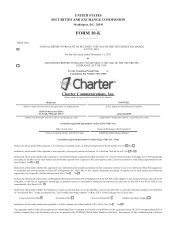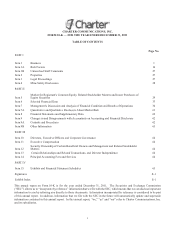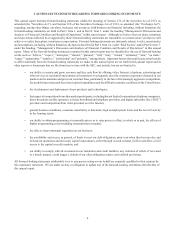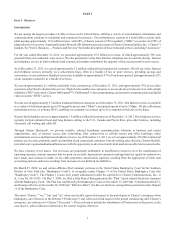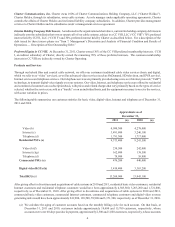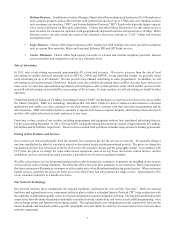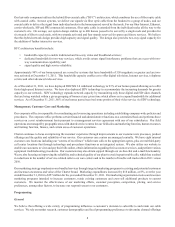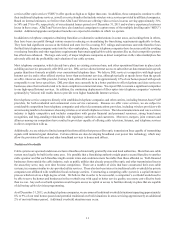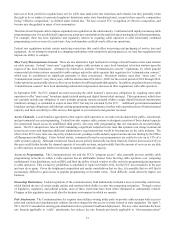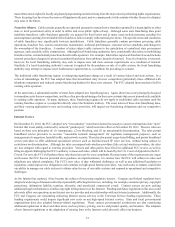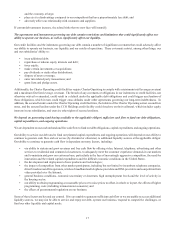Charter 2011 Annual Report Download - page 19
Download and view the complete annual report
Please find page 19 of the 2011 Charter annual report below. You can navigate through the pages in the report by either clicking on the pages listed below, or by using the keyword search tool below to find specific information within the annual report.7
• Medium Business. In addition to its other offerings, Charter also offers medium sized businesses (20-199 employees)
more complex products such as fiber Internet with symmetrical speeds of up to 1 Gbps and voice trunking services
such as primary rate interface (“PRI”) and Session Initiation Protocol ("SIP") Trunks which provide higher-capacity
voice services delivered via fiber optic connection. Charter also offers Metro Ethernet service that connects two or
more locations for commercial customers with geographically dispersed locations with speeds up to 10 Gbps. Metro
Ethernet service can also extend the reach of the customer's local area network or “LAN” within and between
metropolitan areas.
• Large Business. Charter offers large businesses (200+ employees) with multiple sites more specialized solutions
such as custom fiber networks, Metro and long haul Ethernet, PRI and SIP Trunk services.
• Carrier Wholesale. Charter offers high-capacity last-mile to wireless and wireline telephone providers, Internet
service providers and competitive carriers on a wholesale basis.
Sale of Advertising
In 2011, sales of advertising represented approximately 4% of our total revenues. We receive revenues from the sale of local
advertising on satellite-delivered networks such as MTV®, CNN® and ESPN®. In any particular market, we generally insert
local advertising on up to 40 channels. We also provide cross-channel advertising to some programmers. In addition, we sell
advertising on our Internet portal, Charter.net. In most cases, the available advertising time is sold by our sales force, however in
some cases, we enter into representation agreements with contiguous cable system operators under which another operator in the
area will sell advertising on our behalf for a percentage of the revenue. In some markets, we sell advertising on behalf of other
operators.
Charter has deployed Enhanced TV Binary Interchange Format (“EBIF”) technology to set top boxes in select service areas within
the Charter footprint. EBIF is a technology foundation that will allow Charter to deliver enhanced and interactive television
applications and enable our video customers to use their remote control to interact with their television programming and its
advertisements. EBIF will enable Charter’s customers to request such items as coupons, samples, and brochures from advertisers
and also will enable advertisers to reach audiences in new ways.
From time to time, certain of our vendors, including programmers and equipment vendors, have purchased advertising from us.
For the years ending December 31, 2011, 2010 and 2009, we had advertising revenues from vendors of approximately $51 million,
$46 million and $41 million, respectively. These revenues resulted from purchases at market rates pursuant to binding agreements.
Pricing of Our Products and Services
Our revenues are derived principally from the monthly fees customers pay for the services we provide. We typically charge a
one-time installation fee which is sometimes waived or discounted during certain promotional periods. The prices we charge for
our products and services vary based on the level of service the customer chooses and the geographic market. In accordance with
FCC rules, the prices we charge for video cable-related equipment, such as set-top boxes and remote control devices, and for
installation services, are based on actual costs plus a permitted rate of return in regulated markets.
We offer reduced-price service for promotional periods in order to attract new customers, to promote the bundling of two or more
services and to retain existing customers. We often also offer a two-year price guarantee to our customers. There is no assurance
that these customers will remain as customers or at the regular price when the promotional pricing period expires. When customers
bundle services, generally the prices are lower per service than if they had only purchased a single service. Approximately 62%
of our customers subscribe to a bundle of services.
Our Network Technology
Our network includes three components: the national backbone, regional/metro core and the "last-mile." Both our national
backbone and regional/metro core components utilize or plan to utilize a redundant Internet Protocol ("IP”) ring architecture with
the capability to differentiate quality of service for each residential or commercial product offering. The national backbone provides
connectivity from the master headends to nationally centralized content, connectivity and services such as HD programming, voice
interexchange points and Internet interexchange points. The regional/metro core components provide connectivity between the
master headends and headends within a specific geographic area and enable the delivery of content and services between these
network components.


